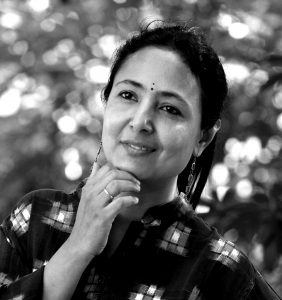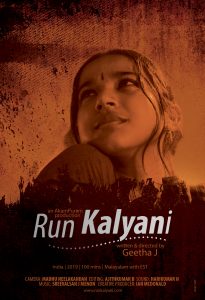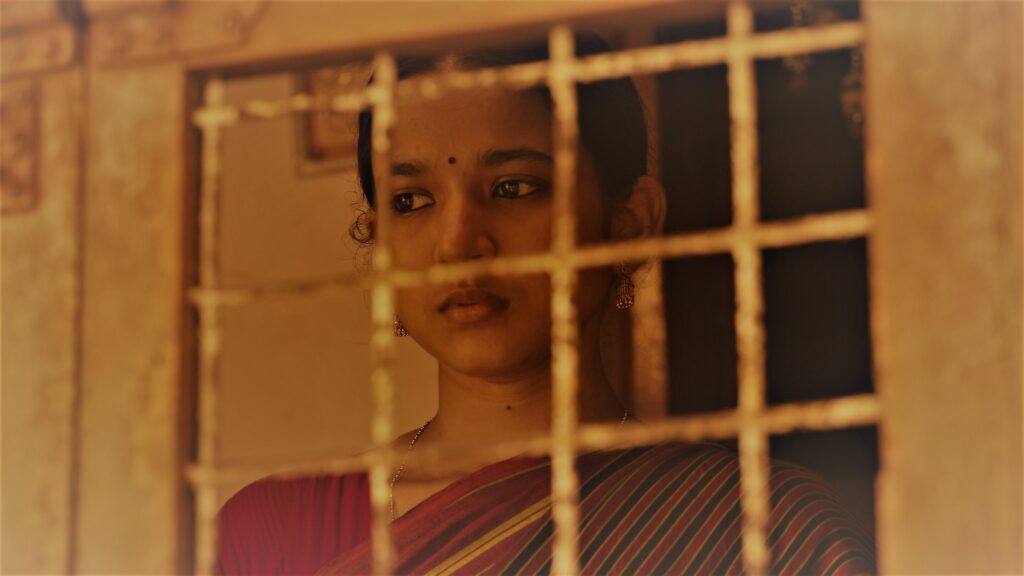Geetha received the Göteborg International Film Festival’s Development Fund for her first script A Certain Slant of Light (2008). However, lack of funding for feature fiction only meant a focus on writing scripts and a return to documentaries as producer. She attended the Berlin Talent Campus in 2009. Her second script End Game was at the Co-Production Market (2014) at Film Bazaar.
Run Kalyani is her debut feature fiction set in Trivandrum, Kerala, and was part of the Work In Progress Lab (2018) at Film Bazaar. It has won the Special Jury Prize at the 25th Kolkata International Film Festival recently. The film drew a packed house when a special screening was held in her native city Thiruvananthapuram. J. Geetha in conversation with Shoma A. Chatterji.

What is the film Run Kalyani all about?
Kalyani is a young cook who lives with her ailing aunt and a young man in a rundown agraharam in Thiruvananthapuram. Each day is the same as she carries on with her life of duty as a cook and caregiver. As the romance of poetry ignites a passion, as the stories of other worlds stirs a desire, as sharks close in and death draws near, Run Kalyani builds into an intense crescendo of grief and grit, sorrow and strength. It is a poetic and realist drama about duties, dreams and desires that draws you into the world of Kalyani.
What or who inspired you to make this film and why?
Women who work silently behind the scenes! I have seen women who work so hard but are shadowy figures and live an unseen life. But is their life any less dramatic? No. And through Kalyani’s eyes we see many other women, and men. This is not a polarised film about men and women. It is about all of us, trapped in a pattern of living, but life is never static. It keeps changing and we have to be alert to that and make the right intervention. It is like a game of chess, really!
Why did you choose an ambiguous title like Run Kalyani?
It has a literal meaning because the story is about Kalyani who we see constantly running in her day-to-day life. Finally, the “running” for her, turns out to be liberation from her routine life; more important is the metaphorical meaning beautifully evoked in the song ‘Aren’t we all running?’

The mad man on the streets and the man under the tree who plays a musical instrument is an insertion. Why?
For me it is important that these characters, mad men and musicians are still there in our streets and are part of our lives. The point is that Kalyani notices them — that is why they feel like insertions and not just background people. Athough they are not central to the plot, they have a place in the film, again the unseen is seen.
The mad man is modelled on a real mad man who used to live near our house in Kerala. He used to dress smartly in white, come to the bus stop at 9 am and talk non-stop the whole day and leave at 5 pm. No one took notice of him. His mixed-up denouncements are also a pointer to the literary and political awareness of the average Malayalee and also to the high incidence of madness in the state!
The musician is a different kind of insertion. Kalyani’s response to him and the musicality of the pattern raises the film to a dream-like moment. Also differences are juxtaposed and harmonised as he plays what we created, the Indian Bolero – an inspired adaptation of Ravel’s Bolero with a nadaswaram!
What issues are you exploring in the film?
There are probably many issues embedded in the pattern of the film that may be picked up by the viewers. Firstly, the film is about families and the secret problems they hide, such as domestic violence. The film is about women, women with dreams, desire and duties. It is about class too, here the Brahmin working class! It is about care for the elderly and total lack of State support or community support for the same. It is about retirement age when able and experienced employees have to retire in mid-fifties. It is about love not just amongst the youth, but amongst the mature adults too. It is about youth and fanciful dreams. It is about inner strength that Kalyani possesses. It is about the place, shot as it is entirely in Trivandrum.
The graffiti on street walls are quite telling. What are you trying to say through these?
The three stars of yesteryear appear in the film. As Kalyani walks by, we can see the two contemporaries of Madhu, the 84-year-old chess-obsessed father, Prem Nazir and Sathyan sketched on the street walls taken over by artists on Sundays in Trivandrum. We also see drawn on the walls famous theatre personalities and poets like Kavalam Narayana Panicker and Kamala Das. Mammootty’s famous lines from Koodevide are referred to by Raghavan and the ruling party’s famous slogan is used by Vijayan.
You have used silence very powerfully through your characters. Why?
Kalyani does not talk much. Vijayan and Nirmala too do not talk much except for a slow but accelerating reciting of poetry that slowly reaches a passionate crescendo. The loneliness and suffering of the protagonists are accentuated by simple gestures and eloquent glances. In fact, the three leading characters speak the least in this ensemble drama. Kalyani listens to the absurd stories of a character who is full of words and weaves beautiful stories. But he is the only character created by Kalyani’s imaginative mind.
Would you like to bracket your film as a woman’s film?
Not really. Run Kalyani is an ensemble drama with equally important male and female characters. However, the women characters signify something more, right from the lead Kalyani to her aunt Rukmini, the two women in the house where she goes to cook and the visiting daughter of the house. When films nowadays including the ‘feminist’ and the ‘art house’ are all becoming shrill and aggressive, I want to seek the steely strength that women have and bring that to life. Kalyani is an amazing character – she is gentle, quiet, caring, but is also made of something stronger and is a survivor.


 [/column]
[/column]